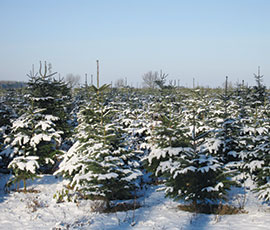Farm boosts profits with Christmas trees

The agriculturally rich county of Lincolnshire may be widely associated with crops such as wheat and potatoes, but in the small village of Fillingham one farm is hoping the area could become equally famous for its Christmas trees.
Situated nine miles north of Lincoln, W & AC Rose Farms stretches over 1,500ha of arable land, including some contract farming.
Twenty years ago the first trees were grown as a “farm add-on” and now 25,000-30,000 trees are planted each year, as demand continues for good-quality Lincolnshire Christmas trees.
Farm manager George Overton says the humble beginnings of Christmas trees on the farm have quickly grown into big business with the farm now employing 15 staff during the peak season from November to December.
“We started growing them on a marginal piece of land that was wet. Those trees were then sold and we have planted every year since then.
“We are currently working towards sales of somewhere around 15,000-20,000, but you always have to plant more than you need.”
George and his team now supply trees across Lincolnshire, Nottinghamshire, Derbyshire, Cambridgeshire, Norfolk and even across the border into Wales.
Agronomy
Christmas trees are grown as a 10-year crop on the farm planting two-year-old trees fresh from the nursery, while the business now works closely with Christmas tree growers across the country.
“We plant the two-year-old trees in the autumn with our two-row planter, which can plant between 8,000 and 9,000 trees a day,” he explains.
Mr Overton aims for the trees to be out the ground the shortest possible time after leaving the nursery and once in the ground, a good rain is next on the list.
“Once they are in, you will get a residual herbicide on in the spring to cope with the usual arable weeds that you would get in a normal crop.
“This will help them get established and away, then in six months’ time you will know whether you’ve got a tree because it will be green or brown.”
Glyphosate is used in the rows to keep weed populations down and 1.5 litres can be sprayed on the trees once the buds are closed over winter.
Using a mixture of specialised and standard farm kit, the trees are then tended to each year until they reach maturity.
“We’ve got a mist blower, a sprayer and a dedicated three-row tractor with mowers and sprayers to keep the weeds down.
“The farm sprayer is a 32m, 5,000-litre RoGator sprayer which can spray the trees at 24m.”
Mr Overton uses the farm’s Amazone spreader to spread three individual splits of fertiliser and a telescopic forklift-mounted spreader to reach the taller trees.
It’s pests that provide the biggest threat to whether a tree will make it home for Christmas, with aphids and other insects the main culprits, carrying diseases and damaging trees.
“We are currently working towards sales of somewhere around 15,000-20,000, but you always have to plant more than you need.”
George Overton, farm manager of W & AC Rose Farms
“You can get certain diseases such as rusts, but it is pest damage from sap-eating aphids that give you weak, funny shaped trees that will take longer to grow,” he explains.
Mr Overton controls those using normal pesticides, but stresses he is as selective as possible using Aphox (pirimicarb) to target particular pests and keep any beneficial species working within the plantation,
A similar procedure is followed year on year, which includes getting the fertiliser on, spraying and pruning to help shape the trees to fit the market, adds Mr Overton.
The pinnacle of each season begins in November when harvest starts and shops begin to fill their shops with every size of Christmas tree available.
With many wholesale customers visiting the plantation in the summer to select their tree, most aim to fill their retailers for the last week of November, meaning a busy period at Fillingham.
“We use steel brush strimmers with a tungsten saw blade and two guys will cut about 1,000 trees in a normal shift if they are cutting trees between 4ft and 6ft.
“They don’t really stop. It is only when you get to the larger trees and you have to use a chainsaw that you have to slow down.”
Each tree is cut, labelled and netted on a self-propelled netter ready to be sent away.
“It is a labour-intensive job, but we get most of wholesale deliveries done in November and then we can concentrate on our own shop and pick-your-own days in December.
“Picking your own has become a popular event with the public choosing their tree out in the field and a date when they would like it to be cut.”
The farm now supplies a host of varieties, including the traditional Norway spruce, blue spruce and Fraser fir.
However, it is the needle-retaining Nordman fir that fills 70% of their market that is proving the most popular.
“We supply anything from a 3ft tree to the run-of-the-mill 6ft trees and then right up to 25ft and above, which are supplied to county councils and stately homes.
“Prices range from £12 into the hundreds, depending on what you want,” he says.
Once December is over it is business as normal on the farm with the traditional arable crops becoming the focus, but with Mr Overton and his team now planting more than ever, these Christmas trees certainly aren’t just for the festive season.
“We are seeing a big demand for good-quality Lincolnshire trees and we’re hopefully building on that.”
Find out about other niche crops

